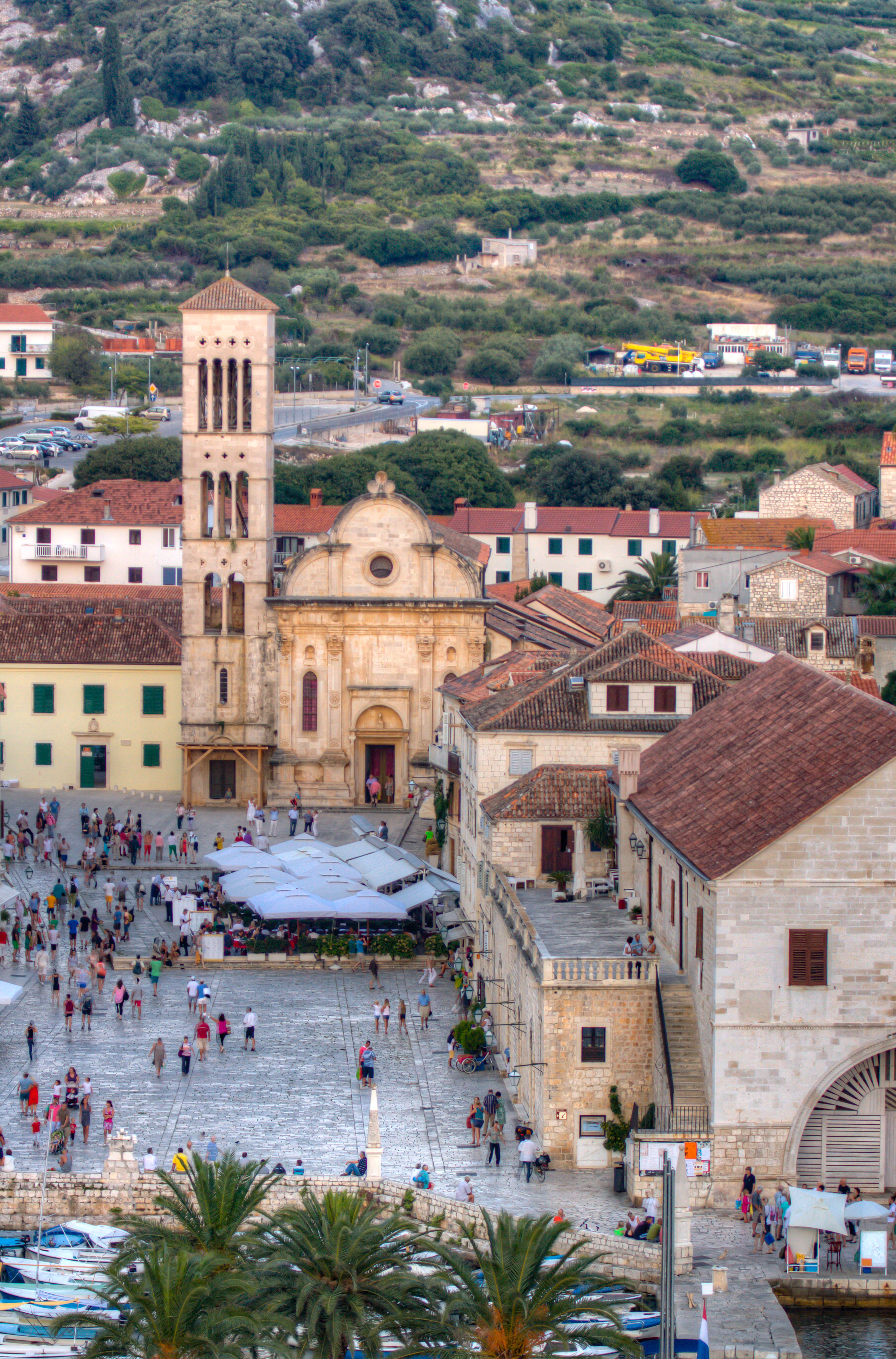Why Visit Now: Split
Dive into its rich culture, luxurious hotels, and thrilling sailing. Go beyond the usual to discover the true essence of Split through unique narratives and experiences that capture the heart and spirit of this vibrant city.
A city known to Croats for its athletes and sports fans, Split grew up inside and around the ancient walls of Diocletian's Palace.
Its cheerful palm-lined seafront promenade, overlooked by open-air cafes (sunglasses are de rigueur), gives onto a wide bay, with a busy ferry port serving the Dalmatian islands, and a sailing marina.
East of the old town lies Bačvice, the town beach, and to the west rises Marjan, a wooded peninsula. Tourism is relatively new here – until recently Split was considered a mere transit point. Although its hotels and restaurants lack the refinement of Dubrovnik's, Split is vibrant and welcoming, and its informality somewhat refreshing.
A walk through its stone alleys is a journey through time, while local color is added by the pazar (farmers market) and peškarija (fish market). And with plenty of adventure activities (the offer keeps expanding), Split is a perfect destination for lovers of the great outdoors.
1. Diocletian's Palace
Completed in 305AD, Diocletian's Palace was the vast and lavish retirement home of Roman Emperor Diocletian.
Split Tourist Board
In 614, refugees from nearby Salona took shelter here, turning the palace's chambers into homes. Gradually an entire city developed, with noble palazzi and additional fortifications added by the Venetians, and modern cafes and boutiques opened by today's residents.
Today it forms the core of Split's gorgeous pedestrian-only old town. Looking onto the sparkling blue Adriatic, it is based on a square plan, with four entrance gates. It centers on the Peristil (a colonnaded square), home to Diocletian's octagonal mausoleum, now the cathedral, with an elegant bell-tower (climb to the top for stunning views).
Diocletian's private quarters, including dining halls and a Roman baths, looked onto the sea, and were accessed off the Peristil, through the domed Vestibul. The soldiers' barracks and servants' lodgings lay at the back of the palace.
2. Croatia's Greatest 20th-century Artist
More than just ancient heritage, Split is also home to the Meštrović Gallery, celebrating Croatia's best-known 20th-century sculptor.
Zoran Alajbeg
Zoran Alajbeg
Originating from a village in the Dalmatian hinterland, Ivan Meštrović (1883-1962) became an apprentice stonemason in Split before studying sculpture in Vienna. He spent time in Paris and Rome, then built this gorgeous 1930's summer villa, set in gardens planted with palms, overlooking the Adriatic Sea. Today it displays dozens of his sculptures, in bronze, marble and wood, both indoors and out.
Some rooms are still furnished just as they were when he lived here. The entrance ticket is valid for nearby Kaštelet, displaying a cycle of 28 wood reliefs illustrating the Life of Christ, by Meštrović, in a 16th-century chapel. Back in the old town, the statue of Grgur Ninski (touch his big toe for good luck) in front of the Zlatna Vrata (Golden Gate) is also by Meštrović.
3. Heritage Hotels
Unlike Dubrovnik, Split doesn't have many big modern 5-star hotels - instead, it has several welcoming heritage hotels in grand historic buildings. These small boutique residences don't have pools or spas, but they do have plenty of old-fashioned charm and offer highly-personalized service.
A favorite is the Fermai Heritage Hotel, opened in 2020 in an elegant Vienna Secession building from 1914. Its 35 rooms have wooden parquet floors, minimalist white décor and vintage furnishing, and bathrooms with either a walk-in showers or elegant free-standing bathtub, and Molton Brown toiletries. The hotel's bar-restaurant serves a sumptuous breakfast.
Photo: Hotel Fermai
In the old town, on the main square, Piazza Heritage Hotel occupies another Vienna Secession building, with a gracious façade embellished with gold stucco. It has 16 rooms with neo-Baroque furnishing, and fabrics in cream and beige.
Piazza Heritage Hotel
There's no restaurant, but breakfast is served at a small eatery in a nearby stone alley.
4. Split Cooking Class
Learn to cook Dalmatian-style, on a half-day course with award-winning local chefs at Škmer (Association of Chefs from Mediterranean & European Regions). Ideal for both beginners and experienced cooks, it's informative and fun.
The morning course begins with a visit to the pazar (farmer's market) and peškarija (fish market) with the chef to buy fresh local seasonal produce.
Jane Foster
Afterwards you'll head to Škmer's modern open-plan kitchen, to make an authentic 5-course Dalmatian meal. This is a hands-on experience, and you'll learn how to clean and prepare the seafood, with step-by-step demonstrations (in English).
Depending on the ingredients you choose, you might make octopus salad, sea bass carpaccio, shrimp risotto, gregada (casserole of fish, potato, onion, white wine and fresh herbs), salad, freshly-baked bread, and rožata (similar to crème caramel). Groups are limited to 12 persons, and afterwards you'll have lunch together, accompanied by wine. Early-evening lessons are also available.
5. Marjan Park Forest
A 10-minute walk west of Split's old town lies Marjan Park Forest, a green oasis of Aleppo pine trees, cypresses, yellow-flowering broom, cacti and agave.
A rugged hilly peninsular jutting out into the Adriatic, it affords sublime views over town and the islands of Brač, Hvar and Šolta. Protected and car-free, it's criss-crossed by footpaths, where locals come to walk, run and cycle, and has several rock-and-pebbles beaches, ideal for swimming.
Split Tourist Board
Marjan's history dates from ancient times. The Greeks and Romans regarded it as sacred, hunting wild boar in the woods, and fishing in the deep waters off the south coast. The Greeks even built a shrine to Artemis, their goddess of wild animals and hunting, near the tip of Marjan. In medieval times, hermits lived in caves on Marjan, seeking God in nature and solitude. Later, small stone churches were built on these sites, and several remain today.
6. Cetina Gorge Rafting Trip
The River Cetina runs through a dramatic rocky gorge, over a series of rapids, to arrive at the sea at Omiš (16mi southeast of Split). It's a superb venue for rafting, canoeing and canyoning, making a perfect half-day trip from Split.
Things to Do on Cetina River:

Rafting
Cetina Rafting, where adventure meets the natural beauty of Split. [Photo: Štefan Barbarić]

A Bend in the River
A little boat weaves through giant boulders on the tranquil waters of the Croatian river Cetina. [Photo by Noah Josue]

More Rapids
Adrenaline Rafting Cetina, a thrilling journey through the rapids of Split's stunning river. [Photo: Štefan Barbarić]
Rafting is safe and easy and doesn't require any special skills – you'll wear life-jackets and helmets, and descend the river aboard an inflatable rubber raft, carrying 6-8 people, captained by a skipper. Canoeing trips follow a similar route, but in this case you'll be rowing your own vessel, either a one-person or two-person canoe, lead by a guide.
Stay Inspired. Explore the World.
Subscribe to the Wayer Journal and discover a world of inspiring stories and Fernwayer's newest, meticulously crafted private tours.
Even more adventurous is canyoning, the exhilarating challenge of wading through the river and rapids in a wetsuit, or zip-lining, traversing the gorge on a wire, high above the tree tops.
While here, you might spot Peregrine falcons and Eurasian eagle-owls, which nest in the plummeting rocky cliffs within the gorge.
7. Brela's Beaches and the Biokovo Skywalk
People from Split generally forgo local beaches and head instead to the fine pebble coves of Brela (32mi southeast of Split).
Brela Tourist Board
Ideal for families, Brela's beaches give onto translucent turquoise waters, and are connected by a lovely seafront promenade. You don't need a parasol here – Brela's beaches are backed by Aleppo pine trees, which cast their shadows over the smooth white pebbles, providing natural shade.
If you want to explore a bit, you can join a guided sea-kayaking trip, or try scuba-diving.
Behind the coast rise the rocky heights of Mount Biokovo (5781ft), its arid limestone slopes supporting scanty pastures, grazed by wild chamois goats and mouflon sheep. Don't miss the spectacular Biokovo Skywalk – a glass horseshoe-shaped walkway, cantilevered over a sheer rock face, at an altitude of 4029ft. Opened in 2020, it affords dizzying views down onto the sea and has become a popular venue for marriage proposals.
8. Trendy Hvar island

Hvar Tourist Board
Glorious Hvar, Croatia's most celebrated island, makes a lovely one-day excursion from Split. With its palm-lined seafront promenade and noble stone buildings rimming a sheltered harbor, Hvar Town attracts celebrities, yachters and newly-weds.
See the vast stone-paved main square overlooked by the Baroque cathedral, the arsenal with its tiny Renaissance theatre, and the 16th-century hilltop castle, affording dreamy views back down onto the bay. For swimming and sunbathing, reserve a four-poster bed on a private pontoon at the glamorous Hvar Beach Club, or hop on a taxi-boat for the uninhabited pine-scented Pakleni islets, home to several secluded pebble coves (some clothing optional, so you can get an all-over tan). Return to town to feast on fresh seafood and other Mediterranean delights at Hvar's rustic-chic open-air restaurants - Macondo and Black Pepper are favorites. Before catching the catamaran back to Split, shop for handcrafted silver jewelry and locally-produced lavender oil.
9. Beaches and Watersports in Bol on Brač
Through summer, each morning a fast catamaran sails from Split direct to Bol on Brač's sunny south coast. From the village, a waterside promenade, shaded by Aleppo pines, leads to Croatia's most stunning beach, Zlatni Rat, lined with sun beds.
Bol Tourist Board
Giving onto turquoise waters ideal for swimming, this fine pebble spit changes shape, depending on prevailing winds. If you prefer something more active, head to the nearby Borak beach.
Bol is Croatia's top windsurfing destination, and Big Blue Sport offer surfing tuition here. Local winds range from the gentle levant in the morning, to the gusty mistral in the afternoon, providing optimum conditions for both beginners and professionals.
Alternatively, behind Bol rise the rocky heights of Vidova Gora (2552ft) the highest peak on all the Dalmatian islands – you can hike up or cycle (Big Blue Sport rent mountain bikes and e-bikes) for superb views over the sea and islands.
10. Split, Croatia's Top Yacht Charter Base
What better way to explore the gorgeous Dalmatian islands than by yacht? Many visitors come to Split specifically to embark on a one-week private charter, staying a night or two before setting sail.
Split Tourist Board
First port of call could be glamorous Hvar, with its centuries-old Venetian-era architecture, boho-chic restaurants and late-night beach parties.
Then onwards to distant Vis, with the unspoiled harbors of Vis Town and Komiža, and amazing dive sites, including plane wrecks and the Blue Cave on Biševo. On the return journey, moor up on Brač's west coast, or on Šolta, close to the translucent Blue Lagoon.
Alternatively, a one-week sailing vacation up the coast from Split could take you to the Krka NP with its thundering waterfalls, and the awe-inspiring rocky islets of Kornati NP. Here await crystal clear waters ideal for snorkeling, limestone hiking trails, rustic waterside fish restaurants, Byzantine forts, hardy sheep and peregrine falcons. ||
